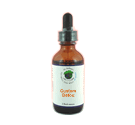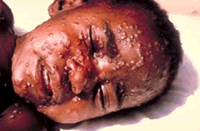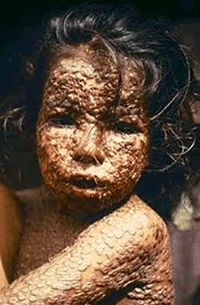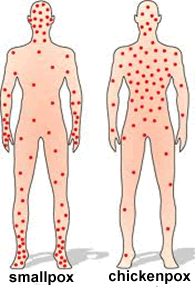|
|
Variola
The variola virus includes several strains, all of which cause various "pox" diseases with the most famous one being Smallpox. Variola caprina is the virus that causes goatpox, and Variola porcina is the virus that causes swinepox. Variola major and minor are the famously known viruses that caused the highly contagious, epidemic (now considered nearly extinct) of smallpox.
The term "smallpox" was first used in Europe in the 15th century to distinguish variola from the "great pox" (syphilis). The disease killed an estimated 400,000 Europeans per year during the closing years of the 18th century (including five reigning monarchs) and was responsible for a third of all blindness. Of all those infected, 20–60%—and over 80% of infected children—died from the disease. Smallpox was responsible for an estimated 300–500 million deaths during the 20th century. This disease was considered eradicated in 1979, with the last naturally occurring case of smallpox diagnosed on October 26, 1977. Most believe smallpox was cured because of the vaccination, but some of the studies indicate that the disease had begun its steady decline and became practically obsolete before the vaccine was created simply because of the natural adaptation of the human immune system.
So why would we include a remedy for a disease that has been "eradicated"? First of all, smallpox still exists. There are not many natural cases reported, but some who have been vaccinated get a form called modified smallpox. The vaccine, which we believe is more toxic to the human body than is positive for prevention, exposes the person vaccinated to a contaminated form of the smallpox virus and can cause variola sine eruptions. This is an indication that the immune system sees this vaccine as toxic and the detox Remedy would be appropriate. In addition, this remedy serves as a detox for all Variola species, including those that affect swine and goats, diseases that still exist today. Lastly, if great economical loss were to bring any nation or culture through a kind of great depression, where civilization went through a kind of 'dark ages' again, we believe Smallpox could once again become an epidemic.
There are two clinical forms of smallpox. Smallpox localizes in small blood vessels of the skin and in the mouth and throat. In the skin, this results in a characteristic maculopapular rash, and later, raised fluid-filled blisters. V. major produces a more serious disease and has an overall mortality rate of 30–35%. V. minor causes a milder form of disease (also known as alastrim, cottonpox, milkpox, whitepox, and Cuban itch) which kills about 1% of its victims. Long-term complications of V. major infection include: characteristic scars, commonly on the face (which occur in 65–85% of survivors), blindness resulting from corneal ulceration and scarring, and limb deformities due to arthritis and osteomyelitis are seen in about 2–5% of cases. In addition, a form called variola sine eruptions (smallpox without rash) is seen generally in vaccinated persons. This form is marked by a fever that occurs after the usual incubation period.
The incubation period between contraction and the first obvious symptoms of the disease is around 12 days. Once inhaled, variola major virus invades the oropharyngeal (mouth and throat) or the respiratory mucosa, migrates to regional lymph nodes, and begins to multiply. In the initial growth phase the virus seems to move from cell to cell, but around the 12th day, the virus is found in the bloodstream in large numbers. Now a second wave of multiplication occurs in the spleen, bone marrow, and lymph nodes.
The initial, prodromal, or preeruptive stage symptoms are similar to other viral diseases such as influenza and the common cold: fever of at least 38.5 °C (101 °F), muscle pain, malaise, headache and prostration. Since the digestive tract is commonly involved, nausea and vomiting and backache often occur. The prodrome stage usually lasts 2–4 days. By days 12–15 the first visible lesions—small reddish spots called enanthem—appear on mucous membranes of the mouth, tongue, palate, and throat, and temperature falls to near normal. These lesions rapidly enlarge and rupture, releasing large amounts of virus into the saliva.
Smallpox virus preferentially attacks skin cells, causing the characteristic pimples (called macules) associated with the disease. A rash develops on the skin 24 to 48 hours after lesions on the mucous membranes appear. Typically the macules first appear on the forehead, then rapidly spread to the entire face, proximal portions of extremities, the trunk, and lastly to distal portions of extremities. The process takes no more than 24 to 36 hours, after which no new lesions appear. At this point variola major infection can take several very different courses, resulting in four types of smallpox disease based on the Rao classification: ordinary, modified, malignant (or flat), and hemorrhagic.
|
|
| |
Variola virus Detox Remedy
Detoxification of all Variola virus and related species
$14.95
Read/Write Reviews
|
 Add
To Cart Add
To Cart |
 |
 |
Herpes Detox Remedy
Detoxification of all Herpes and related species
$14.95
|
 Add
To Cart Add
To Cart |
 |
 |
Influenza Detox Remedy
Detoxification of all Influenza and related species
$14.95
|
 Add
To Cart Add
To Cart |
 |
 |
Mumps Detox Remedy
Detoxification of all Mumps and related species
$14.95
|
 Add
To Cart Add
To Cart |
 |
 |
|
|
 Arthropod/Vector
Bacteria
Chemicals
Fungus /Mold
/ Yeast Metals Parasites Virus Other
Arthropod/Vector
Bacteria
Chemicals
Fungus /Mold
/ Yeast Metals Parasites Virus Other




